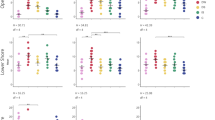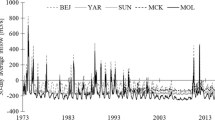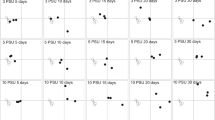Abstract
Tidal freshwater marshes around the world face an uncertain future with increasing water levels, salinity intrusion, and temperature and precipitation shifts associated with climate change. Due to the characteristic abundance of both annual and perennial species in these habitats, even small increases in early growing season water levels may reduce seed germination, seedling establishment, and late-season plant cover, decreasing overall species abundance and productivity. This study looks at the distribution of tidal freshwater marsh plant species at Jug Bay, Patuxent River (Chesapeake Bay, USA), with respect to intertidal elevation, and the relationship between inundation early in the growing season and peak plant cover to better understand the potential impacts and marsh responses to increased inundation. Results show that 62% of marsh plant species are distributed at elevations around mean high water and are characterized by narrow elevation ranges in contrast with species growing at lower elevations. In addition, the frequency and duration of inundation and water depth to which the marsh was exposed to, prior to the growing season (March 15–May 15), negatively affected peak plant cover (measured in end-June to mid-July) after a threshold value was reached. For example, 36 and 55% decreases in peak plant cover were observed after duration of inundation threshold values of 25 and 36% was reached for annual and perennial species, respectively. Overall, this study suggests that plant communities of tidal freshwater marshes are sensitive to even small systematic changes in inundation, which may affect species abundance and richness as well as overall wetland resiliency to climate change.





Similar content being viewed by others
References
Baldwin, A.H., and E.F. DeRico. 1999. The seed bank of a restored tidal freshwater marsh in Washington, DC. Urban Ecosystems 3: 5–20.
Baldwin, A.H., M.S. Egnotovich, and E. Clarke. 2001. Hydrologic change and vegetation of tidal freshwater marshes: Field, greenhouse, and seed bank experiments. Wetlands 21: 519–531.
Baldwin, A.H., A. Barendregt, and D.F. Whigham. 2009. Tidal freshwater wetlands—An introduction to the ecosystem. Chapter 1. In Tidal freshwater wetlands, ed. A. Barendregt, D.F. Whigham, and A.H. Baldwin, 1–10. Leiden: Backhuys Publishers 320 pp.
Baldwin, A.H., K. Jensen, and M. Schönfeldt. 2014. Warming increases plant biomass and reduces diversity across continents, latitudes, and species migration scenarios in experimental wetland communities. Global Change Biology 20: 835–850.
Barendregt, A., and C.W. Swarth. 2013. Tidal freshwater wetlands: Variation and changes. Estuaries and Coasts 36: 445–456.
Bockelmann, A., J. Bakker, R. Neuhaus, and J. Lage. 2002. The relation between vegetation zonation, elevation and inundation frequency in a Wadden Sea salt marsh. Aquatic Botany 73: 211–221.
Boon, J.D., J.M. Brubaker, and D.R. Forrest. 2010. Chesapeake Bay land subsidence and sea level change: An evaluation of past and present trends and future outlook. A report to the U.S. Army Corps of Engineers Norfolk District, VA. Special Report No. 425. Gloucester Point: Virginia Institute of Marine Science.
Boumans, R., M. Ceroni, D. Burdick, D. Cahoon, and C. Swarth. 2002. Sediment elevation dynamics in tidal marshes: Functional assessment of accretionary biofilters. CICEET Final Report for the period of 8/15/1999 through 8/15/2002. Durham: Cooperative Institute for Coastal and Estuarine Environmental Technology.
Brush, G.R., E.A. Martin, R.S. Defries, and C.A. Rice. 1982. Comparisons of 210Pb and pollen methods for determining rates of estuarine sediment accumulation. Quaternary Research 18 (02): 196–217. https://doi.org/10.1016/0033-5894(82)90070-9.
Bullock, A.L., A.E. Sutton-Grier, and J.P. Megonigal. 2013. Anaerobic metabolism in tidal freshwater wetlands: III. Temperature regulation of iron cycling. Estuaries and Coasts 36: 482–490.
Casanova, M.T., and M.A. Brock. 2000. How do depth duration and frequency of flooding influence the establishment of wetland plant communities? Plant Ecology 147: 237–250.
Childers, D.L., F.H. Sklar, B. Darkes, and T. Jordan. 1993. Seasonal measurements of sediment elevation in three mid-Atlantic estuaries. Journal of Coastal Research 9 (4): 986–1003.
Craft, C., J. Clough, J. Ehman, S. Joye, R. Park, S. Pennings, H. Guo, and M. Machmuller. 2009. Forecasting the effects of accelerated sea-level rise on tidal marsh ecosystem services. Frontiers in Ecology and the Environment 7: 73–78.
Delgado, P., P.F. Hensel, C.W. Swarth, M. Ceroni, and R. Boumans. 2013. Sustainability of a tidal freshwater marsh exposed to a long-term hydrologic barrier and sea level rise. Estuaries and Coasts 36: 585–594.
Ezer, T., L.P. Atkindson, W.B. Corlett, and J.L. Blanco. 2013. Gulf Stream’s induced sea level rise and variability along the U.S. mid-Atlantic coast. Journal of Geophysical Research: Oceans 118: 1–13.
Field, R.T., and K.R. Philipp. 2000. Vegetation changes in the freshwater tidal marsh of the Delaware estuary. Wetlands Ecology and Management 8: 79–88.
Gao, H., J. Bai, X. He, Q. Zhao, Q. Lu, and J. Wang. 2014. High temperature and salinity enhance soil nitrogen mineralization in a tidal freshwater marsh. PLoS One 9 (4): e95011. https://doi.org/10.1371/journal.pone.0095011.
Gosselink, J.G., and R.E. Turner. 1978. The role of hydrology in freshwater wetland ecosystems. In Freshwater wetlands, ed. R.E. Good, D.F. Whigham, and R.L. Simpson. New York: Academic Press.
Khan, H., and G.S. Brush. 1994. Nutrient and metal accumulation in a freshwater tidal marsh. Estuaries 17 (2): 345–360. https://doi.org/10.2307/1352668.
Kozlowski, T.T. 1984. Plant responses to flooding of soil. Bioscience 34: 162–167.
Leck, M.A., and R.L. Simpson. 1995. Ten year seed bank and vegetation dynamics of a tidal freshwater marsh. American Journal of Botany 82: 1547–1557.
Leck, M.A., C.C. Baskin, and J.M. Baskin. 1994. Germination ecology of Bidens laevis (Asteraceae) from a tidal freshwater wetland. Bulletin of the Torrey Botanical Club 121: 230–239.
Leck, M.A., A.H. Baldwin, V.T. Parker, L. Schile, and D.F. Whigham. 2009. Plant communities of tidal freshwater wetlands of the continental USA and Canada. In Tidal freshwater wetlands, ed. A. Barendregt, D.F. Whigham, and A.H. Baldwin, 41–58. Leiden: Backhuys.
Lynch, J.C., P. Hensel, and D.R. Cahoon. 2015. The surface elevation table and marker horizon technique: A protocol for monitoring wetland elevation dynamics. Natural Resource Report. NPS/NCBN/NRR–2015/1078. Fort Collins: National Park Service.
McKee, K.L., and I.A. Mendelssohn. 1989. Response of a freshwater marsh plant community to increased salinity and increased water level. Aquatic Botany 34: 301–316.
Miller, K.G., R.E. Kopp, B.P. Horton, J.V. Browning, and A.C. Kemp. 2013. A geological perspective on sea-level rise and its impacts along the U.S. mid-Atlantic coast. Earth’s Future. https://doi.org/10.1002/2013EF000135.
Moore, K.R. 2009. NERRS SWMP Bio-monitoring protocol: Long-term monitoring of estuarine submersed and emergent vegetation communities. National Estuarine Research Reserve System Technical Report. https://coast.noaa.gov/data/docs/nerrs/Research_TechSeries_TechReportSWMPBio-MonitoringProtocol.pdf.
Morris, J.T., P.V. Sundareshwar, C.T. Nietch, B.R. Kjerfve, and D.R. Cahoon. 2002. Responses of coastal wetlands to rising sea level. Ecology 83: 2869–2877.
National Estuarine Research Reserve System (NERRS) 2012. Sentinel sites program guidance for climate change impacts. A guidance document for determining effects of changing sea level/lake level and inundation on coastal habitats. Technical Report. http://www.nerrs.noaa.gov/Doc/PDF/Research/TechReportSWMPBio-MonitoringProtocol.pdf.
Neubauer, S.C. 2013. Ecosystem responses of a tidal freshwater marsh experiencing saltwater intrusion and altered hydrology. Estuaries and Coasts 36: 491–507.
Odum, W.E. 1988. Comparative ecology of tidal freshwater and salt marshes. Annual Review of Ecology and Systematics 19: 147–176.
Odum, W.E., T.J. Smith III, J.K. Hoover, and C.C. McIvor. 1984. The ecology of tidal freshwater marshes of the United States east coast: A community profile. Washington, DC: U.S. Fish and Wildlife Service FWSIOBS-83117.
Parker, V.T., and M.A. Leck. 1985. Relationships of seed banks to plant distribution patterns in a freshwater tidal wetland. American Journal of Botany 72: 161–174.
Perry, J.E., D.M. Bilkovic, K.J. Havens, and C.H. Hershner. 2009. Tidal freshwater wetlands of the mid-Atlantic and southeastern United States. In Tidal freshwater wetlands, ed. A. Barendregt, D.F. Whigham, and A.H. Baldwin, 257–310. Leiden: Backhuys.
Peterson, J.E., and A.H. Baldwin. 2004. Seedling emergence from seed banks of tidal freshwater wetlands: Response to inundation and sedimentation. Aquatic Botany 78: 243–254.
Silvestri, S., A. Defina, and M. Marani. 2005. Tidal regime, salinity and salt marsh plant zonation. Estuarine, Coastal and Shelf Science 62: 119–130.
Simpson, R.L., R.E. Good, M.A. Leck, and D.F. Whigham. 1983. The ecology of freshwater tidal wetlands. Bioscience 33: 255–259.
Stevenson, C.J., and M.S. Kearney. 2009. Impacts of global climate change and sea-level rise on tidal wetlands. In Human impacts on salt marshes: A global perspective, ed. B.R. Silliman, E.D. Grosholz, and M.D. Bertness. Berkeley: University of California Press.
Suchrow, S., and K. Jensen. 2010. Plant species responses to an elevational gradient in German North Sea salt marshes. Wetlands 30: 735–746.
Swarth, C.W., P. Delgado, and D.F. Whigham. 2013. Vegetation dynamics in a tidal freshwater wetlands: A long-term study at differing scales. Estuaries and Coasts 36: 559–574.
Ward, L.G., M.S. Kearney, and J.C. Stevenson. 1998. Variations in sedimentary environments and accretionary patterns in estuarine marshes undergoing rapid submergence, Chesapeake Bay. Marine Geology 151: 111–134.
Williams, S.J. 2013. Sea-level rise implications for coastal regions. Journal of Coastal Research Special Issue 63: 184–196. https://doi.org/10.2112/SI63-015.1.
Acknowledgements
The authors would like to thank the Maryland Chesapeake Bay National Estuarine Research Reserve (CBNERR-MD) for providing the resources and facilitating the establishment and continued sampling of all sentinel site monitoring infrastructure through the present day. Special thanks go to CBNERR-MD staff, Jug Bay Wetlands Sanctuary staff, and Friends of Jug Bay volunteers who helped year after year with the collection of data, including Lindsay Carroll, Cathy Ervin, Becky Lang, Julia Pusak, Katrina Keller, Lindsay Hollister, Heather Baden, Chris Snow, Jenny Allen, Amanda Garzio-Hadzick, Erica Loudermilk, and Regina Kreger. The authors wish to thank Jay Howard (NOAA NGS) for his help in processing the water level data. Special recognition goes to Erica Loudermilk for her field and data analytical contribution regarding species and marsh elevation while doing a summer research internship at Jug Bay during the summer of 2015.
Author information
Authors and Affiliations
Corresponding author
Additional information
Communicated by Cathleen Wigand
Rights and permissions
About this article
Cite this article
Delgado, P., Hensel, P. & Baldwin, A. Understanding the Impacts of Climate Change: an Analysis of Inundation, Marsh Elevation, and Plant Communities in a Tidal Freshwater Marsh. Estuaries and Coasts 41, 25–35 (2018). https://doi.org/10.1007/s12237-017-0342-y
Received:
Revised:
Accepted:
Published:
Issue Date:
DOI: https://doi.org/10.1007/s12237-017-0342-y




